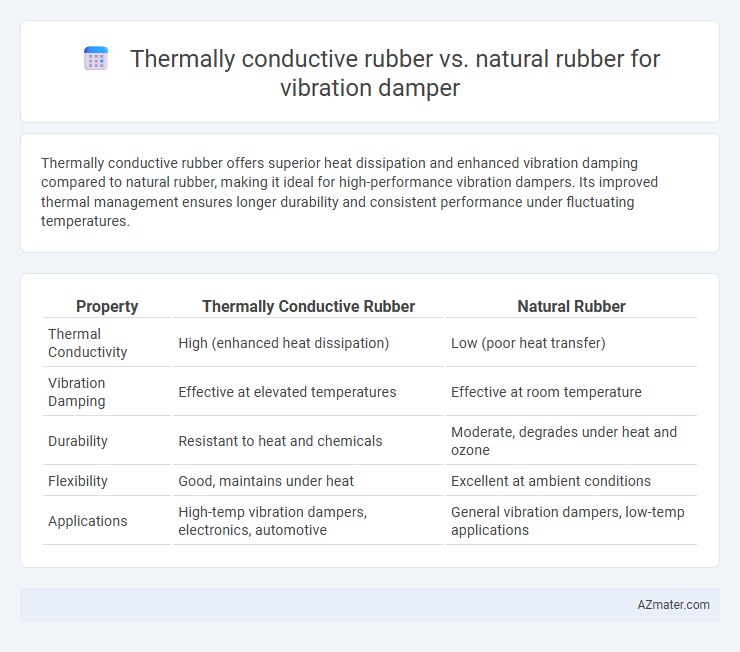Thermally conductive rubber offers superior heat dissipation and enhanced vibration damping compared to natural rubber, making it ideal for high-performance vibration dampers. Its improved thermal management ensures longer durability and consistent performance under fluctuating temperatures.
Table of Comparison
| Property | Thermally Conductive Rubber | Natural Rubber |
|---|---|---|
| Thermal Conductivity | High (enhanced heat dissipation) | Low (poor heat transfer) |
| Vibration Damping | Effective at elevated temperatures | Effective at room temperature |
| Durability | Resistant to heat and chemicals | Moderate, degrades under heat and ozone |
| Flexibility | Good, maintains under heat | Excellent at ambient conditions |
| Applications | High-temp vibration dampers, electronics, automotive | General vibration dampers, low-temp applications |
Introduction to Vibration Dampers
Thermally conductive rubber enhances vibration dampers by efficiently dissipating heat generated during mechanical vibrations, improving durability and performance compared to natural rubber. Natural rubber, while providing excellent elasticity and damping properties, lacks the thermal conductivity needed to manage heat buildup in high-stress applications. Selecting thermally conductive rubber in vibration dampers optimizes thermal management, extending service life in automotive, industrial, and electronic systems.
Overview of Thermally Conductive Rubber
Thermally conductive rubber enhances vibration damping by efficiently dissipating heat generated from mechanical stress, preventing material degradation and maintaining performance under high-temperature conditions. This rubber type incorporates thermally conductive fillers such as carbon black, graphite, or boron nitride, which improve thermal conductivity while retaining elasticity and durability. Compared to natural rubber, thermally conductive rubber offers superior thermal management, making it ideal for vibration dampers in electronic devices and automotive components requiring heat dissipation and sustained mechanical resilience.
Properties of Natural Rubber in Vibration Dampening
Natural rubber exhibits excellent vibration dampening properties due to its high elasticity and resilience, allowing it to absorb and dissipate energy effectively. Its superior tensile strength and tear resistance contribute to durability under repetitive stress, making it ideal for vibration dampers in automotive and industrial applications. However, natural rubber's thermal conductivity is low, which limits its performance in high-temperature environments compared to thermally conductive rubber options.
Thermal Management: Key Differences
Thermally conductive rubber enhances vibration dampers by efficiently dissipating heat generated during mechanical stress, maintaining optimal operating temperatures and preventing material degradation. Natural rubber exhibits poor thermal conductivity, causing heat accumulation that can reduce damper performance and lifespan. The superior thermal management of thermally conductive rubber ensures improved durability and consistent damping capabilities under high thermal loads.
Mechanical Properties Comparison
Thermally conductive rubber exhibits higher elasticity and better heat dissipation compared to natural rubber, making it more effective in maintaining mechanical stability under fluctuating temperatures in vibration dampers. Natural rubber offers superior tensile strength and resilience, providing excellent shock absorption but with limited thermal conductivity. The enhanced thermal conductivity in thermally conductive rubber reduces heat buildup, improving durability and performance in high-frequency vibration damping applications.
Durability and Longevity
Thermally conductive rubber offers superior durability and longevity compared to natural rubber when used in vibration dampers, due to its enhanced heat dissipation properties that prevent material degradation under high-temperature conditions. Its ability to maintain structural integrity and resist wear over extended use reduces maintenance frequency and replacement costs. Natural rubber, while flexible and cost-effective, tends to deteriorate faster in environments with continuous vibration and temperature fluctuations, leading to shorter service life in damping applications.
Temperature Stability and Performance
Thermally conductive rubber exhibits superior temperature stability compared to natural rubber, maintaining consistent damping performance across a wider temperature range from -40degC to 150degC. This enhanced thermal conductivity dissipates heat effectively, preventing performance degradation in high-temperature environments. Natural rubber, while flexible, tends to lose elasticity and damping efficiency under elevated temperatures, limiting its effectiveness for vibration dampers in demanding applications.
Applications in Industrial Settings
Thermally conductive rubber offers enhanced heat dissipation capabilities, making it ideal for vibration dampers in industrial settings where machinery generates significant heat. In contrast, natural rubber provides excellent elasticity and damping properties but lacks the thermal conductivity required for high-temperature environments. Applications such as automotive engines, heavy machinery, and electronic equipment benefit from thermally conductive rubber to maintain performance and prevent overheating.
Cost Analysis and Availability
Thermally conductive rubber generally incurs higher costs due to specialized fillers like boron nitride or aluminum oxide, which enhance heat dissipation but increase manufacturing expenses. Natural rubber offers a more cost-effective solution, benefiting from widespread availability and lower raw material costs, making it suitable for budget-conscious vibration damper applications. Availability of natural rubber is more consistent globally, whereas thermally conductive rubber may face supply chain variability linked to its advanced material components.
Conclusion: Choosing the Right Rubber for Vibration Dampers
Thermally conductive rubber provides superior heat dissipation and stable mechanical properties under high temperatures, making it ideal for vibration dampers in electronics and automotive applications exposed to heat. Natural rubber offers excellent elasticity and damping performance at a lower cost but lacks thermal conductivity, limiting its effectiveness in high-temperature environments. Selecting the right rubber depends on the operational temperature range and the need for heat management alongside vibration isolation performance.

Infographic: Thermally conductive rubber vs Natural rubber for Vibration damper
 azmater.com
azmater.com